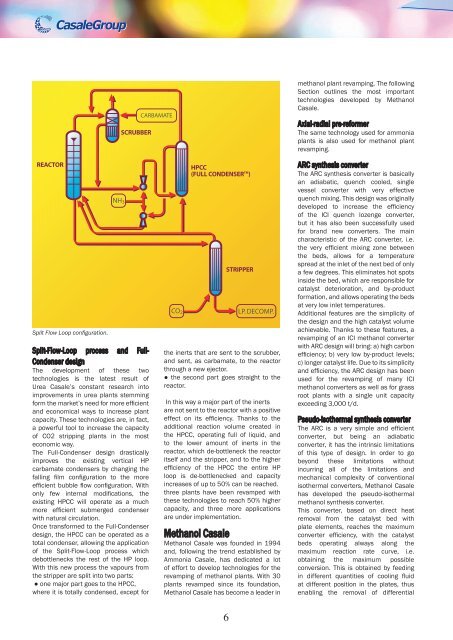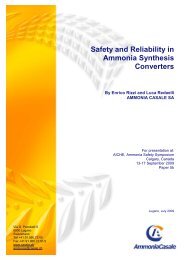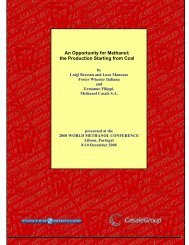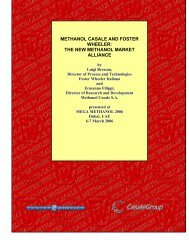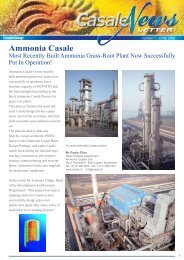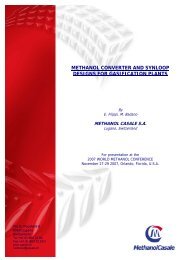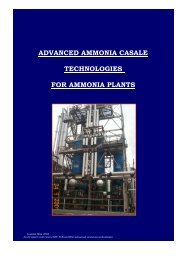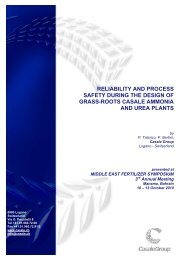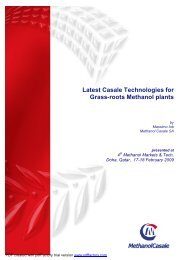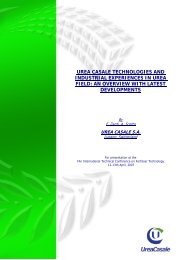The most Advanced Technologies for ... - CASALE GROUP
The most Advanced Technologies for ... - CASALE GROUP
The most Advanced Technologies for ... - CASALE GROUP
Create successful ePaper yourself
Turn your PDF publications into a flip-book with our unique Google optimized e-Paper software.
REACTOR<br />
Split Flow Loop confi guration.<br />
NH3<br />
SCRUBBER<br />
Split-Flow-Loop process and Full-<br />
Condenser design<br />
<strong>The</strong> development of these two<br />
technologies is the latest result of<br />
Urea Casale’s constant research into<br />
improvements in urea plants stemming<br />
<strong>for</strong>m the market’s need <strong>for</strong> more effi cient<br />
and economical ways to increase plant<br />
capacity. <strong>The</strong>se technologies are, in fact,<br />
a powerful tool to increase the capacity<br />
of CO2 stripping plants in the <strong>most</strong><br />
economic way.<br />
<strong>The</strong> Full-Condenser design drastically<br />
improves the existing vertical HP<br />
carbamate condensers by changing the<br />
falling fi lm confi guration to the more<br />
effi cient bubble fl ow confi guration. With<br />
only few internal modifi cations, the<br />
existing HPCC will operate as a much<br />
more effi cient submerged condenser<br />
with natural circulation.<br />
Once trans<strong>for</strong>med to the Full-Condenser<br />
design, the HPCC can be operated as a<br />
total condenser, allowing the application<br />
of the Split-Flow-Loop process which<br />
debottlenecks the rest of the HP loop.<br />
With this new process the vapours from<br />
the stripper are split into two parts:<br />
● one major part goes to the HPCC,<br />
where it is totally condensed, except <strong>for</strong><br />
CARBAMATE<br />
HPCC<br />
(FULL CONDENSER TM )<br />
6<br />
STRIPPER<br />
CO2 LP. DECOMP.<br />
the inerts that are sent to the scrubber,<br />
and sent, as carbamate, to the reactor<br />
through a new ejector.<br />
● the second part goes straight to the<br />
reactor.<br />
In this way a major part of the inerts<br />
are not sent to the reactor with a positive<br />
effect on its effi ciency. Thanks to the<br />
additional reaction volume created in<br />
the HPCC, operating full of liquid, and<br />
to the lower amount of inerts in the<br />
reactor, which de-bottleneck the reactor<br />
itself and the stripper, and to the higher<br />
effi ciency of the HPCC the entire HP<br />
loop is de-bottlenecked and capacity<br />
increases of up to 50% can be reached.<br />
three plants have been revamped with<br />
these technologies to reach 50% higher<br />
capacity, and three more applications<br />
are under implementation.<br />
Methanol Casale<br />
Methanol Casale was founded in 1994<br />
and, following the trend established by<br />
Ammonia Casale, has dedicated a lot<br />
of ef<strong>for</strong>t to develop technologies <strong>for</strong> the<br />
revamping of methanol plants. With 30<br />
plants revamped since its foundation,<br />
Methanol Casale has become a leader in<br />
methanol plant revamping. <strong>The</strong> following<br />
Section outlines the <strong>most</strong> important<br />
technologies developed by Methanol<br />
Casale.<br />
Axial-radial pre-re<strong>for</strong>mer<br />
<strong>The</strong> same technology used <strong>for</strong> ammonia<br />
plants is also used <strong>for</strong> methanol plant<br />
revamping.<br />
ARC synthesis converter<br />
<strong>The</strong> ARC synthesis converter is basically<br />
an adiabatic, quench cooled, single<br />
vessel converter with very effective<br />
quench mixing. This design was originally<br />
developed to increase the effi ciency<br />
of the ICI quench lozenge converter,<br />
but it has also been successfully used<br />
<strong>for</strong> brand new converters. <strong>The</strong> main<br />
characteristic of the ARC converter, i.e.<br />
the very effi cient mixing zone between<br />
the beds, allows <strong>for</strong> a temperature<br />
spread at the inlet of the next bed of only<br />
a few degrees. This eliminates hot spots<br />
inside the bed, which are responsible <strong>for</strong><br />
catalyst deterioration, and by-product<br />
<strong>for</strong>mation, and allows operating the beds<br />
at very low inlet temperatures.<br />
Additional features are the simplicity of<br />
the design and the high catalyst volume<br />
achievable. Thanks to these features, a<br />
revamping of an ICI methanol converter<br />
with ARC design will bring: a) high carbon<br />
effi ciency; b) very low by-product levels;<br />
c) longer catalyst life. Due to its simplicity<br />
and effi ciency, the ARC design has been<br />
used <strong>for</strong> the revamping of many ICI<br />
methanol converters as well as <strong>for</strong> grass<br />
root plants with a single unit capacity<br />
exceeding 3,000 t/d.<br />
Pseudo-isothermal synthesis converter<br />
<strong>The</strong> ARC is a very simple and effi cient<br />
converter, but being an adiabatic<br />
converter, it has the intrinsic limitations<br />
of this type of design. In order to go<br />
beyond these limitations without<br />
incurring all of the limitations and<br />
mechanical complexity of conventional<br />
isothermal converters, Methanol Casale<br />
has developed the pseudo-isothermal<br />
methanol synthesis converter.<br />
This converter, based on direct heat<br />
removal from the catalyst bed with<br />
plate elements, reaches the maximum<br />
converter effi ciency, with the catalyst<br />
beds operating always along the<br />
maximum reaction rate curve, i.e.<br />
obtaining the maximum possible<br />
conversion. This is obtained by feeding<br />
in different quantities of cooling fl uid<br />
at different position in the plates, thus<br />
enabling the removal of differential


